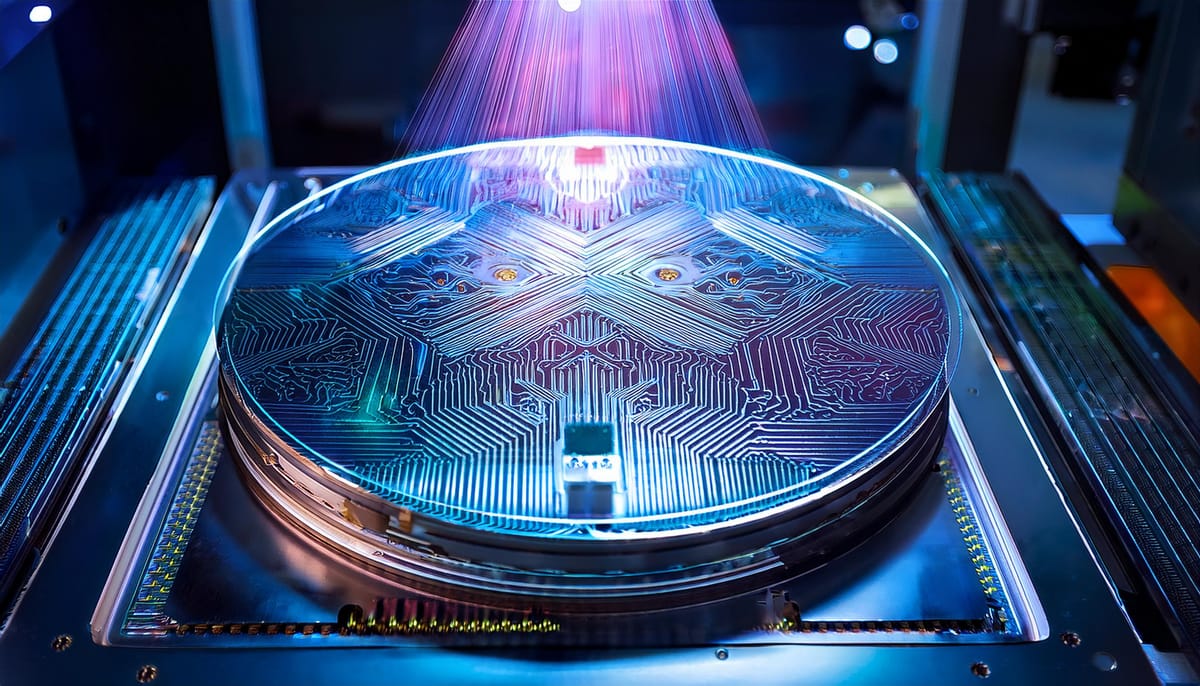The semiconductor industry is at the heart of technological progress, powering everything from our smartphones to advanced AI systems. As a leading global supplier in this field, I'm excited to share insights on the top trends in semiconductor production equipment that are shaping the future of manufacturing in this critical sector.
The Evolution of Extreme Ultraviolet (EUV) Lithography
One of the most significant advancements in semiconductor manufacturing in recent years has been the adoption of extreme ultraviolet (EUV) lithography. This technology is revolutionizing the way we produce the most advanced chips, allowing for smaller transistors and more powerful processors.
The ASML Monopoly
When it comes to EUV lithography, ASML, based in the Netherlands, has effectively cornered the market on EUV machines, creating a virtual monopoly in this critical technology. Peter Wennink, CEO of ASML, recently stated:
"EUV is now the workhorse lithography technology for leading-edge chip manufacturing. We're seeing strong demand from our customers as they ramp up their EUV capabilities to meet the growing need for advanced semiconductors."
This quote underscores the importance of EUV technology in the semiconductor manufacturing process. However, we need to approach this with a critical eye. While ASML's dominance in EUV is impressive, it also presents risks. Any disruption to ASML's production or supply chain could have far-reaching consequences for the entire semiconductor industry.

The High Costs of EUV Adoption
One of the biggest challenges with EUV lithography is its cost. These semiconductor manufacturing equipment units are incredibly complex and expensive, with each unit costing upwards of $150 million. This high cost of entry creates a significant barrier for smaller players in the industry and contributes to the consolidation we're seeing among chip manufacturers.
Taiwan Semiconductor Manufacturing Company (TSMC), the world's largest contract chipmaker, has been investing heavily in EUV technology. Mark Liu, Chairman of TSMC, commented:
"The transition to EUV lithography is crucial for maintaining our technology leadership. While the initial investment is substantial, we believe it's necessary to meet the increasing demands of our customers for more advanced chips."
This statement highlights the strategic importance of EUV technology in semiconductor processing, but it also raises questions about the long-term sustainability of such high capital expenditures.

The Rise of Advanced Packaging Technologies
While much attention is focused on the front-end processes like lithography, there's a revolution happening in the back-end of chip manufacturing as well. Advanced packaging technologies are becoming increasingly important as we push the limits of Moore's Law.
Fan-Out Wafer-Level Packaging (FOWLP)
Fan-Out Wafer-Level Packaging (FOWLP) is gaining traction as a way to improve performance, reduce form factor, and lower costs for certain types of semiconductor devices. This technology allows for better integration of different components and can be particularly beneficial for mobile and IoT devices.
C.C. Wei, CEO of TSMC, shared his thoughts on advanced packaging:
"Advanced packaging technologies like our InFO (Integrated Fan-Out) are becoming a key differentiator in the industry. They allow us to continue scaling performance and functionality even as traditional node scaling becomes more challenging."
This quote highlights the growing importance of packaging technologies in the overall semiconductor fabrication process. However, it's important to note that while companies like TSMC are investing heavily in these technologies, they're not a silver bullet for all the challenges facing the industry.
Chiplets and Disaggregation
Another trend I'm watching closely is the move towards chiplet-based designs and disaggregation. This approach involves breaking down complex chip designs into smaller, modular components that can be mixed and matched to create customized solutions.
Lisa Su, CEO of Advanced Micro Devices (AMD), has been a strong proponent of chiplet technology:
"Our chiplet-based approach has been a game-changer for us, allowing us to deliver higher performance and better value to our customers. We believe this is the future of chip design and manufacturing."
While the potential benefits of chiplets are significant, including improved yields and more flexible designs, the transition to this approach also presents challenges. It requires new design methodologies, testing procedures, and manufacturing processes. As we look at semiconductor equipment manufacturers, those that can provide solutions for chiplet-based manufacturing may have a significant advantage in the coming years.
AI-Driven Process Control and Optimization
Artificial intelligence is making its way into every aspect of semiconductor manufacturing, from design to process control and yield optimization. This trend is driven by the increasing complexity of chip designs and the need for ever-tighter process controls.
Machine Learning for Defect Detection
One area where AI is making a significant impact is in defect detection and classification. Advanced machine learning algorithms can analyze vast amounts of data from inspection systems to identify and classify defects more accurately and quickly than ever before.
Gary Dickerson, CEO of Applied Materials, emphasized the importance of AI in semiconductor manufacturing:
"AI is not just a product we're helping our customers create; it's also a critical tool in the manufacturing process itself. Our AIx platform is helping chipmakers accelerate the time to market for new chip designs while improving yields and reducing costs."
This statement underscores the dual role of AI in the semiconductor industry - both as an end product and as a tool for improving the manufacturing process. However, the implementation of AI systems in semiconductor fabs is not without challenges. It requires significant investment in both hardware and software solutions, as well as specialized expertise to develop and maintain these systems.
Predictive Maintenance and Process Optimization
Another promising application of AI in semiconductor manufacturing is predictive maintenance and process optimization. By analyzing data from equipment sensors and process parameters, AI systems can predict when maintenance is needed and optimize process recipes in real-time.
Lam Research, a leading supplier of wafer fabrication equipment, has been at the forefront of this trend. Tim Archer, CEO of Lam Research, shared:
"Our AI-powered solutions are helping our customers move from reactive to predictive maintenance, significantly reducing downtime and improving overall equipment effectiveness. This is becoming a key differentiator in the industry."
While the potential benefits of AI-driven process control and optimization are significant, it's important to approach this trend with a critical eye. The effectiveness of these systems depends heavily on the quality and quantity of data available, as well as the specific algorithms used.
The Push for More Environmentally Sustainable Manufacturing
As the semiconductor industry continues to grow, there's increasing pressure to make manufacturing processes more environmentally sustainable. This trend is driven by a combination of regulatory requirements, customer demands, and the industry's own recognition of the need to reduce its environmental footprint.
Reducing Water and Energy Consumption
Semiconductor manufacturing is notoriously resource-intensive, particularly when it comes to water and energy usage. Many leading companies are now focusing on ways to reduce consumption and improve efficiency.
Intel, for example, has set ambitious goals for sustainability. Pat Gelsinger, CEO of Intel, stated:
"We're committed to achieving net positive water use by 2030, conserving billions of gallons of water and funding external water restoration projects. It's not just the right thing to do; it's essential for the long-term sustainability of our industry."
While these efforts are commendable, it's important to recognize the challenges involved. Reducing water and energy consumption while maintaining or improving chip quality and yields is no small feat. As we evaluate semiconductor equipment manufacturers, those that can provide solutions to help chip makers meet their sustainability goals may have a significant advantage in the coming years.
Development of Eco-Friendly Materials and Processes
Another important aspect of sustainability in semiconductor manufacturing is the development of more eco-friendly materials and processes. This includes efforts to reduce the use of harmful chemicals and to develop more efficient cleaning and etching processes.
Tokyo Electron, a major supplier of semiconductor production equipment, has been working on these challenges. Toshiki Kawai, CEO of Tokyo Electron, shared:
"We're focused on developing equipment and processes that reduce the environmental impact of semiconductor manufacturing. This includes new approaches to etching and cleaning that use less chemicals and produce less waste."
These efforts are crucial for the long-term sustainability of the industry, but they also present significant technical challenges. The development of new materials and processes requires extensive research and testing to ensure they meet the exacting standards required for semiconductor manufacturing.
The Impact of Geopolitics on the Semiconductor Supply Chain
No discussion of trends in semiconductor manufacturing would be complete without addressing the elephant in the room: geopolitics. The semiconductor industry has become a focal point of international tensions, particularly between the United States and China.
Reshoring and Supply Chain Diversification
In response to these geopolitical pressures, we're seeing a trend towards reshoring of semiconductor manufacturing and diversification of supply chains. This is particularly evident in the United States and Europe, where there are efforts to reduce reliance on Asian manufacturers.
Jensen Huang, CEO of NVIDIA, commented on this trend:
"The world has woken up to the fact that semiconductors are a strategic industry. We're likely to see more geographical diversification in semiconductor manufacturing in the coming years."
While the push for more geographically diverse semiconductor manufacturing is understandable from a strategic perspective, it presents significant challenges. Building new fabs is incredibly expensive and time-consuming, and it requires a skilled workforce that may not be readily available in all locations.
Export Controls and Their Impact on Equipment Manufacturers
The implementation of export controls, particularly by the United States, has had a significant impact on semiconductor equipment manufacturers. Companies like Applied Materials, Lam Research, and KLA have seen restrictions on their ability to sell certain advanced technologies to Chinese customers.
Dan Durn, CFO of Applied Materials, addressed this issue in a recent earnings call:
"While the export controls create near-term challenges, we're confident in our ability to navigate these restrictions and continue to serve our global customer base. We're also seeing increased demand from customers outside of China as they seek to build up their domestic manufacturing capabilities."
This statement highlights the complex dynamics at play. While export controls may limit opportunities in certain markets, they're also driving increased investment in semiconductor manufacturing in other regions.
Frequently Asked Questions
What are the equipment used in semiconductor manufacturing?
Semiconductor manufacturing requires a broad range of sophisticated equipment. This includes:
- Lithography systems (like ASML's EUV machines)
- Thin film deposition equipment
- Etching tools
- Ion implantation systems
- Metrology and inspection equipment
- Cleaning and surface preparation tools
- Dicing machines
- Packaging and assembly equipment
Each of these plays a crucial role in the complex process of creating integrated circuits on silicon wafers.
What is needed to manufacture semiconductors?
Manufacturing semiconductors requires a combination of highly specialized equipment, ultra-pure materials, and advanced processes. Key requirements include:
- Cleanroom facilities to minimize contamination
- Silicon wafers as the base material
- A variety of gases and chemicals for different processes
- Highly skilled technicians and engineers
- Sophisticated software for design and process control
- Stringent quality control measures
- A robust supply chain for materials and components
The semiconductor fabrication process is incredibly complex, involving hundreds of steps and precise control over every aspect of the manufacturing environment.
Who makes equipment for chip manufacturing?
Several global companies specialize in producing semiconductor manufacturing equipment. Some of the leading providers include:
- ASML (lithography)
- Applied Materials (broad range of equipment)
- Lam Research (etching and deposition)
- KLA (inspection and metrology)
- Tokyo Electron (various process equipment)
- SCREEN Semiconductor Solutions (cleaning and coating)
- ASM International (deposition)
- Teradyne (testing equipment)
These companies, along with many others, form a crucial part of the semiconductor industry ecosystem, providing the tools and technologies needed to produce advanced chips.
How are semiconductor devices manufactured?
The manufacturing process for semiconductor devices involves several key steps:
- Wafer production: High-purity silicon is formed into thin wafers.
- Photolithography: Circuit patterns are projected onto the wafer surface.
- Etching: Unwanted material is removed to create the circuit pattern.
- Doping: Impurities are added to specific areas to alter electrical properties.
- Thin film deposition: Layers of conducting or insulating materials are added.
- Planarization: The wafer surface is smoothed for subsequent layers.
- Repeating steps 2-6 multiple times to create complex chip structures.
- Wafer testing: Each chip on the wafer is tested for functionality.
- Packaging: The wafer is cut into individual chips, which are then packaged.
- Final testing: Packaged chips undergo final tests before shipping.
This process requires extreme precision and cleanliness at every stage, with many steps repeated dozens or even hundreds of times to create a single chip.
Conclusion: Navigating the Complexities of Semiconductor Manufacturing
As we look at these trends in semiconductor production equipment, it's clear that the industry is facing both incredible opportunities and significant challenges. The push for more advanced technologies, from EUV lithography to AI-driven process control, is driving innovation and creating new possibilities for chip design and manufacturing.
At the same time, the industry is grappling with substantial headwinds. The massive capital requirements for new fabs and advanced equipment create high barriers to entry and contribute to industry consolidation. Environmental concerns are pushing companies to rethink their manufacturing processes and invest in more sustainable technologies. And geopolitical tensions are reshaping global supply chains and creating new uncertainties for equipment manufacturers.
As a leading developer and global supplier in this space, we're focused on navigating these complexities successfully. This means not just developing cutting-edge technologies, but also demonstrating the flexibility to adapt to changing market conditions and regulatory environments. It means balancing the need for innovation with financial discipline and a focus on long-term sustainability.
The semiconductor industry has always been cyclical, with periods of boom and bust. But the current environment feels different, with structural changes that could reshape the industry for years to come. As a participant in this industry, I'm both excited and cautious about what the future holds. The companies that can successfully ride these waves of change - delivering the advanced technologies needed for next-generation chips while navigating the complex business and geopolitical landscape - are the ones that will thrive in the years to come.
In the end, the trends we've discussed - from EUV lithography and advanced packaging to AI-driven manufacturing and sustainability efforts - are all part of the industry's relentless push forward. Despite the challenges, I remain optimistic about the future of semiconductor manufacturing. After all, in our increasingly digital world, the demand for more powerful, efficient, and specialized chips is only going to grow. The question is not if we'll need advanced semiconductor production equipment, but who will be best positioned to provide it in this complex and rapidly evolving landscape.
As we continue to innovate and push the boundaries of what's possible in semiconductor fabrication, we're not just creating better chips - we're enabling the technologies that will shape our future. From 5G and AI to quantum computing and beyond, the advances we're making in semiconductor manufacturing equipment today will power the electronic devices and industrial applications of tomorrow. It's an exciting time to be part of this industry, and I look forward to seeing what new breakthroughs and innovations the coming years will bring.






